Description
“Brunswick Centre 1970s”
In the Brunswick Centre two apartment complexes rise away from a central concrete concourse, where initially there were few shops and vast areas of empty space. It was an area to pass through, not to use. (The Fall of Public Man, by Richard Sennett, 1974)
A materially raw architecture may impose transits in public spaces. Correspondently, a void public space, such as the plain stage, may not favour any other use than passing by.
The performers decide to use calculated internal relations, randomness as well as mutual looks, motions and states in order to arrive a point where a constant interchange between the formal/public and the informal/private person takes place through constant navigation in the bare performative space.
Uniformity and abstraction assist the appearance of personhood.
Created and performed by Costas Kekis and Quim Bigas
Costumes by H&M-the uniform of the worldDescription
“Brunswick Centre 1970s”
In the Brunswick Centre two apartment complexes rise away from a central concrete concourse, where initially there were few shops and vast areas of empty space. It was an area to pass through, not to use. (The Fall of Public Man, by Richard Sennett, 1974)
A materially raw architecture may impose transits in public spaces. Correspondently, a void public space, such as the plain stage, may not favour any other use than passing by.
The performers decide to use calculated internal relations, randomness as well as mutual looks, motions and states in order to arrive a point where a constant interchange between the formal/public and the informal/private person takes place through constant navigation in the bare performative space.
Uniformity and abstraction assist the appearance of personhood.
Created and performed by Costas Kekis and Quim Bigas
Costumes by H&M-the uni
“Brunswick Centre 1970s”
In the Brunswick Centre two apartment complexes rise away from a central concrete concourse, where initially there were few shops and vast areas of empty space. It was an area to pass through, not to use. (The Fall of Public Man, by Richard Sennett, 1974)
A materially raw architecture may impose transits in public spaces. Correspondently, a void public space, such as the plain stage, may not favour any other use than passing by.
The performers decide to use calculated internal relations, randomness as well as mutual looks, motions and states in order to arrive a point where a constant interchange between the formal/public and the informal/private person takes place through constant navigation in the bare performative space.
Uniformity and abstraction assist the appearance of personhood.
Created and performed by Costas Kekis and Quim Bigas
Costumes by H&M-the uniform of the world

Estoy en Viena de residéncia con Costas Kekis trabajando en una colaboración.
El punto de partida de la propuesta (despúes de compartir el deseo de trabajar juntos) són dos libros: «The Fall of Public Man de Richard Sennett (Ed. Norton & Company) y «The poetics of Space de Gaston Bachellard (Ed. Beacon Press).
Hemos estado hablando mucho de la relación de lo publico y lo privado. Como estos dos elementos han ido evolucionando en la historia y como, en cierta manera, uno se come al otro. Hemos «evoluvionado» hacía una sociedad que ha oprimido a lo publico y que ha sacrificado a lo publico por el individuo. El libro de Sennett, que recomiendo, és un analisis historico de como desde el s.XVIII al siglo XX han cambiado los codigos y como la politica, las artes y el uso de lo publico resuena en estos días.
Me ayuda saber de que todo tiene un precedente cuando hablamos en terminos de sociedad y cuando intentamos buscar explicaciones a cosas que nos persiguen. Hay algo de inercia en todo esto que me pone los pelos de punta. Sennett habla de revoluciones, de libertad, de individuos, de comunidad colectiva, de artistas y narcisismo entre otras cosas.
En esta colaboración nos hemos centrado en el uso de lo publico, y en los espacios muertos. Así como en la mención del hombre como actor del s.XIX con Diderot y Rousseau.
Os adjunto una parte del texto en el que habla de Brunswick Centre:
In the Brunswick Centre two enormous apartment complexes rise away from a central concrete concourse; the apartment buildings are stepped back story after story, so that each looks like a Babylonian terrace city sited on a hill. The terraces of the Brunswick Centre apartments are covered in glass for the most part; thus the apartment dweller has a greenhouse wall letting in a great deal of light and breaking down the barrier between inside and outside. This permeation of the house and the outside is curiously abstract; one has nice sense of the sky, but the buildings are so angled that they have no relationship to, or view out on, the surrounding buildings of Bloomsbury. Indeed, the rear end of one of the apartment blocks, faced in solid concrete, gives on, or rather ignores, one of the most beautiful squares in all of London. The building is sited as though it could be anywhere, which is to say it’s siting shows its designers had no sense of being anywhere in particular, much less in an extraordinary urban milieu.
The real lesson of Brunswick Centre is contained in its central concourse. Here there are few shops and vast areas of empty space. Here is an area to pass through, not to use; to sit on one of the few concrete benches in the concourse for any length of time is to become profoundly uncomfortable, as though one were on exhibit in a vast empty hall. The “public” concourse of the centre is in fact shielded from the main contiguous Bloomsbury streets by two immense ramps with fences edging them; the concourse itself is raised several feet above street level. Everything has been done, again, to isolate the public area of Brunswick Centre from accidental street incursion, or from simple strolling, just as the siting of the two apartment blocks effectively isolates those who inhabit them, from street, concourse, and square. The visual statement made by the detailing of the greenhouse wall is that the inside and the outside of the dwelling have no differentiation; the social statement made by the concourse, the siting of the complex, and the ramps is that an immense barrier separates “within” the Brunswick Centre from “without”.
The Fall of Public Man by Richard Sennett (first edition 1974)
Podría seguir hablando, peró sé que debo parar. No por nada, sino porque me siento pretencioso cuando escribo. Con Tea-tron intento entrenar-me. Felicidades a los que han llegado hasta aquí.
Una canción: http://www.youtube.com/watch?v=1TKQcWEXSKU



